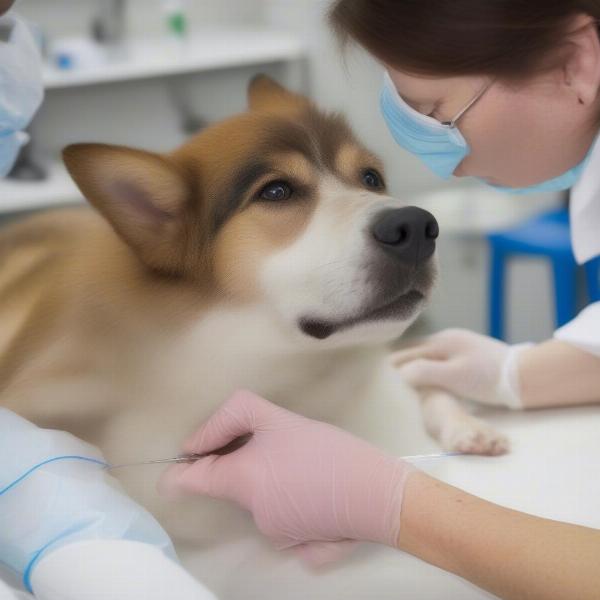Spaying, also known as female dog desexing, is a common surgical procedure that removes the ovaries and uterus, preventing pregnancy and heat cycles. Many pet owners are concerned about the female dog desexing recovery time and what to expect during this period. This guide will provide a comprehensive overview of the typical recovery timeline, post-operative care, and potential complications to help you ensure a smooth and comfortable recovery for your furry friend.
Understanding the Spaying Procedure and Initial Recovery
The spaying procedure involves general anesthesia and an incision in the abdomen. The extent of the surgery can vary slightly depending on the individual dog and the vet’s technique. Immediately following the surgery, your dog will be monitored closely as she wakes up from the anesthesia. This initial recovery period can last a few hours, and your vet will likely keep her overnight for observation. During this time, it’s normal for your dog to experience some grogginess, disorientation, and perhaps some slight discomfort.
Week 1: Rest and Restricted Activity
The first week after spaying is crucial for healing. Your vet will prescribe pain medication and possibly antibiotics to prevent infection. Restricting your dog’s activity is paramount during this time to allow the incision to heal properly. This means no running, jumping, or playing. Short, leashed walks for bathroom breaks are permitted. Keep the incision area clean and dry. You may need to use an Elizabethan collar (e-cone) to prevent your dog from licking or chewing at the stitches.
Week 2: Gradual Increase in Activity
By the second week, your dog should be starting to feel more like herself. You can gradually increase her activity level, but avoid strenuous exercise. Monitor the incision for any signs of infection, such as redness, swelling, or discharge. des for dogs will help you understand the purpose and benefits of this procedure.
Weeks 3-4: Continued Healing and Monitoring
During weeks three and four, the incision should be mostly healed. Most vets will schedule a check-up around this time to remove any remaining stitches or staples. You can continue to increase your dog’s activity levels, but avoid rough play or excessive running until cleared by your vet. desexing male dogs is also a common procedure, with a different recovery process.
 Vet Checking Dog Incision
Vet Checking Dog Incision
What to Watch For: Potential Complications
While complications are rare, it’s important to be aware of potential issues and contact your vet immediately if you notice any of the following:
- Excessive bleeding or discharge from the incision
- Swelling, redness, or heat around the incision
- Lethargy or loss of appetite
- Vomiting or diarrhea
- Difficulty breathing
- Pale gums
Long-Term Benefits of Spaying
The recovery period might seem challenging, but the long-term benefits of spaying are numerous. Spaying eliminates the risk of unwanted pregnancies, reduces the risk of certain cancers, and eliminates the behaviors associated with heat cycles. pros and cons of desexing male dogs can provide insights into the decision-making process for both male and female dogs.
Female Dog Desexing Recovery Time: FAQs
- How long does it take for a female dog to recover from being spayed? The full recovery typically takes about two to four weeks.
- What are the signs of infection after spaying? Redness, swelling, discharge, and heat around the incision are signs of potential infection.
- When can I bathe my dog after spaying? Wait at least 10-14 days after surgery or until your vet gives you the okay.
- Can my dog jump or run after being spayed? No, restrict activity for the first two weeks.
- Is it normal for my dog to be tired after spaying? Yes, lethargy is common, especially in the first few days.
- When should I remove my dog’s stitches? Your vet will schedule a follow-up appointment to remove stitches or staples, usually around 2 weeks after surgery.
- What should I feed my dog after spaying? Stick to her regular diet unless your vet recommends otherwise.
Related Articles
About ILM Dog
ILM Dog is your trusted resource for expert advice on dog care and wellbeing. We cover a range of topics, including breed selection, health, training, nutrition, grooming, and product recommendations. Whether you’re a new dog owner or a seasoned pro, our mission is to provide you with the information you need to give your furry friend the best possible care. For personalized advice or to learn more about our services, contact us at [email protected] or +44 20-3965-8624.